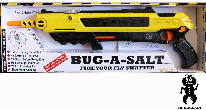While you can always use some harsh chemicals to help get rid of those creepy crawly pests that seem to pop up everywhere around the home, why do it? There are other methods that you can use which are less harsh, and that carry lower consequences if accidents happen. Looking into some natural pest control options isn't all that hard, and can be very effective. Below you will find some of the more common pests you may encounter around the house, as well as a few natural options you can use to take care of them.
- Ants. Ants are a pain in the rear end, and often times they can be somewhat difficult to get rid of. However, a fairly effective method that you can use is to spray a little bit of soapy water to help kill the ants. You can also try soaking a cotton ball or two into a solution made of one liter of water and one teaspoon of borax and a cup of sugar. Place the cotton balls near an ant traffic path, and they will begin to swarm it. The ants will then take the poison back to the colony, which will spread and kill off the colony. Use care with this method since it could be harmful to pets and children.
- Dust mites. A good method for getting rid of dust mites is to do some regular thorough washing at 130 degrees Fahrenheit. Another method that you can use is to regularly vacuum items such as mattress, pillows, rugs, carpeting, and cleaning any drapes that you may have. In addition, you may want to avoid using any humidifiers, or possibly try using a dehumidifier, since dust mites absolutely love humid conditions.
- Cockroaches. The best deterrent to cockroaches is having a clean home, however that doesn't always do the job completely. Believe it or not catnip is a natural cockroach repellent, and isn't harmful to pets. By placing a little bit of catnip into some boiling water you can create a wonderful catnip infusion that you can later on spray in areas that you may see cockroaches and help drive them away.
- Mosquitoes. Remove any and all standing water sources that you may have around your home. These are the natural breeding grounds for mosquitoes, and by removing them you go a long way to removing the mosquito problem. However, if you still find yourself faced with a mosquito problem try mixing together a natural bug repellent using the following recipe. Mix together on part garlic juice with five parts water into a spray bottle. Remember to shake well before you begin to use it so that it is thoroughly mixed.
Author Bio
Lee Wyatt
Contributor of numerous Tips.Net articles, Lee Wyatt is quickly becoming a regular "Jack of all trades." He is currently an independent contractor specializing in writing and editing. Contact him today for all of your writing and editing needs! Click here to contact. Learn more about Lee...
Saute Pans
Saute pans...what's that? Have you ever wondered what a saute pan is and what makes it special or different when compared ...
Discover More
Recognizing Childhood Obesity
It seems like you can't turn on the news, television, or even the radio anymore without hearing something about childhood ...
Discover More
Deciding on What to Plant
For many people deciding on what to plant in their garden can be one of the most difficult steps to creating a new garden ...
Discover More
Getting Rid of Termites
Getting rid of termites is so important that if termites show up in a home inspection, it can potentially threaten the ...
Discover More
Preventing Household Bugs
While it might be nice to learn methods you can use to remove bugs from your home, wouldn't it be better to learn how to ...
Discover More
Ridding Your Home of Silverfish
The best way to rid your home of silverfish is to create a non-friendly environment for them to live in. Keep your home ...
Discover More

Comments